
Credit: Niels Proctor, UF/IFAS
Scientific Name
Dolichandra unguis-cati (L.) L.G. Lohmann
Common Names
cat's-claw vine
catclaw vine
cat's claw creeper
Synonyms
Batocydia unguis-cati
Bignonia unguis
Bignonia unguis-cati
Dolichandra kohautiana
Doxantha radicans
Doxantha unguis-cati
Macfadyena unguis-cati
Family
Bignoniaceae
Description
Cat's-claw vine is a neotropical, climbing perennial that produces large and showy yellow flowers in the springtime. It is valued as an ornamental, particularly in dry areas, because it needs little water or care and can climb almost anything, covering fences and other structures with an attractive carpet of leaves and flowers. Unfortunately, the aggressive nature of the vine has made it a major nuisance in China, Australia, South Africa, and parts of the southeastern United States (Osunkoya et al. 2009). In fact, it is prohibited to sell, purchase, plant, or transport the species in Florida (UF/IFAS Assessment 2019).
Cat's-claw vine is often listed in floras and guidebooks under the older name of Macfadyena unguis-cati, but it has recently been moved to the genus Dolichandra (Lohmann and Taylor 2014). The common name of the plant comes from its most distinctive feature: the cat-like "claws" that help it climb. The vine has opposite leaves that are usually compound and composed of a pair of leaflets with a 3-pronged tendril between them (Figure 2). The tips of each prong are curved, stiff, and so very sharp that they will catch on the individual ridges of a human fingerprint.
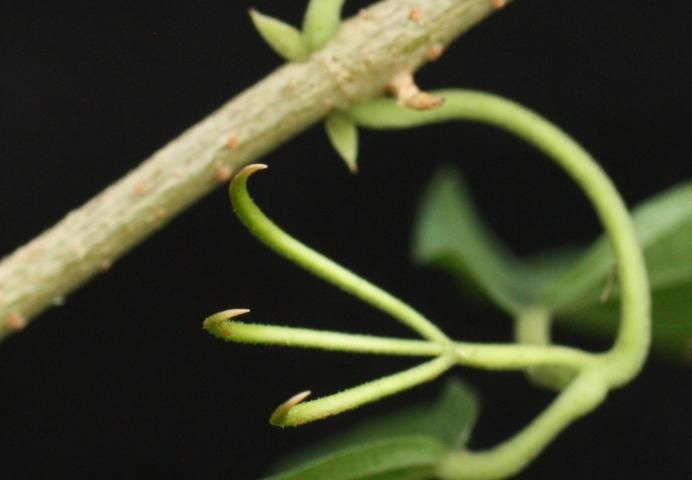
Credit: Niels Proctor, UF/IFAS
History
Cat's-claw vine is native to the West Indies and to Central and South America. It was probably first brought to the United States as an ornamental, sometime early in the 20th century. The first record of the plant in Florida is from a specimen that was collected in Dade County, west of Miami, in 1957 (F.C. Craighead 17, FLAS 733071). The collection record does not indicate whether the introduction was thought to be by humans or by natural dispersal. The following year, two distinct specimens were collected on the main campus of the University of Florida in Gainesville (Erdman West, FLAS 732992; L.E. Arnold, FLAS 733363). In 1973, a collector who pressed a sample for the UF Herbarium noted that the plant had naturalized and become "a pest here" on the UF campus (F.G. Meyer / P.M. Mazzeo 13483, FLAS 1473044 & 1473055).
Horticultural Uses
If grown on a sturdy trellis in full sun, cat's-claw can produce a thick covering of leaves with many showy flowers. The vine has reportedly been used in California to cover cinder block walls and chain-link fences (UCD Department of Plant Sciences 2009). Growers should take care, however, to be sure that the vine does not escape and grow into other areas where it is not wanted. The aggressive growth of the vine can quickly cover and smother ornamental shrubs and other plants.
Nuisance Problem
Cat's-claw vine is currently listed as a Category I invasive plant on the Florida Invasive Species Council’s 2019 List of Invasive Plant Species; although it is listed under its older name of Macfadyena unguis-cati (FISP 2019). Invasive plants are listed as a Category I invasive "when they are altering native plant communities by displacing native species, changing community structures or ecological functions, or hybridizing with natives". Cat's-claw vine disrupts natural communities by climbing in the forest canopy and producing a thick blanket of vegetation that can smother trees and prevent sunlight from reaching plants below. Under certain conditions, the growth of the vine can be very aggressive. In Australia, multiple cat's-claw vines have been observed to grow and fuse together over time to form a single mass resembling the trunk of a tree. One such trunk discovered in 2010 in New South Wales was reportedly "the diameter of a car tyre" and required two men to lift out the cut section after it was cut with a chainsaw (Anonymous 2010).
Cat's-claw vine can climb up to 50' high and produce flowers and fruit at the top of the forest canopy. The wind-dispersed seeds are released free of obstruction at a great height, allowing them to travel long distances. It was originally believed that the vines propagated vegetatively, through the spread of the root structures, but it is now thought that most new recruitment of vines comes from seed dispersal (Osunkoya et al. 2009).
Distribution in Florida
Reports from the Early Detection and Distribution Mapping System (http://www.eddmaps.org) show that cat's-claw vine is found around several cities in central to northern Florida. The largest number of reports come from the Gainesville area, with smaller numbers of sightings in Ocala, Jacksonville, Orlando, and Tampa. There are also reports of the vine in the greater Miami area. The vine is a nuisance in citrus groves in the mid-peninsular region from Brevard County west to Hillsborough County. Evidence suggests that the range of the plant is still expanding and that there are many more areas in Florida where it could become a problem. A climate study examining the habitats where cat's-claw might spread in Australia and South Africa also found that virtually the entire peninsula of Florida (south of 30 degrees latitude) had high habitat potential for the vine (Rafter et al. 2008). An article written in 2005 warned that the vines were invading San Felasco Hammock to the north of Gainesville, "where their eradication may now be impossible" (Ward 2005).
Identification
During their brief bloom season in Florida, cat's-claw vines are most noticeable and recognizable by their flowers, which are large, bright yellow, and very showy (Figure 1). The five petals on each flower are fused to form a trumpet shape, with three lobes on the lower lip and two lobes on the upper one. The flowers generally appear in early- to mid-April in Florida and can persist through the summer. The vine only flowers in full sunlight. While the flowers can be at eye level when the vine is grown on a fence, they are more often far above and well out of sight when the vine is growing in a forested area. The corolla tube drops off after pollination and, in forested areas, the flowers are seen more often on the ground than on the vine up in the canopy.
Outside of the blooming season, cat's-claw vine is most recognizable by its climbing habit and by the blanket of vegetation it creates over other plants. The compound leaves that appear above ground level on the vines are opposite and generally consist of two leaflets with a sharply clawed tendril between them. The "claws" are most likely to be seen on the newer, actively growing tips of the vine, where they are helping it climb (Figure 1). Once the vine has progressed further up a tree and no longer needs to cling to a lower spot, the older leaves commonly lose the tendril and consist only of the two leaflets (Figure 3).
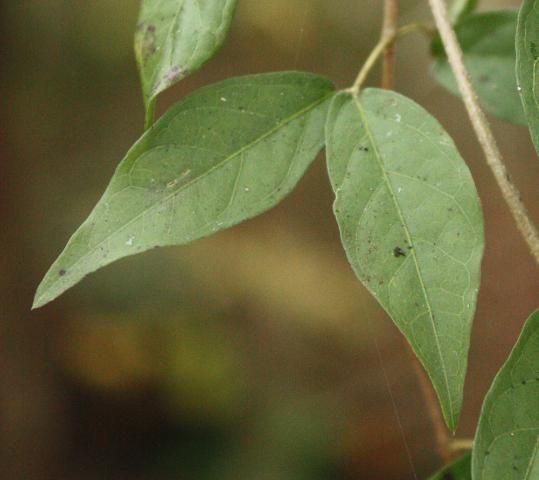
Credit: Niels Proctor, UF/IFAS
Ground-level identification of cat's-claw is complicated by the fact that the early leaves that form on each stem do not have the distinctive claws and do not appear to even be compound. Each leaf in a ground-level pair has only a single blade, making it either a simple leaf or a unifoliolate leaf (i.e., a compound leaf that consists of only a single leaflet) (Boyne et al. 2013). The blade is ovate to elliptic and the margin has shallow, broad serrations. A forest invaded by cat's-claw can have a dense carpet of plants in this "simple-leaved phase" that are capable of choking out all other low vegetation (Figure 4). Plants will remain in this phase for many years and continue to accumulate and store energy until they have the resources and opportunity to climb.
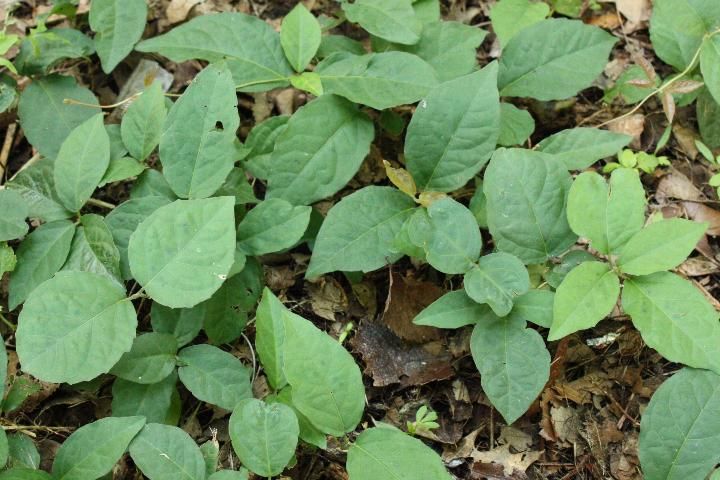
Credit: Niels Proctor, UF/IFAS
The fruits of cat's-claw vine are long, flattened capsules resembling string beans (Figure 5). They are initially bright green, but they dry to a dark brown and crack open to release around 50 seeds apiece. The seeds are brown and elliptic, with two papery wings that stretch out on either side (Figure 6). Each seed is roughly 4cm long by 1cm wide and only a few millimeters thick.
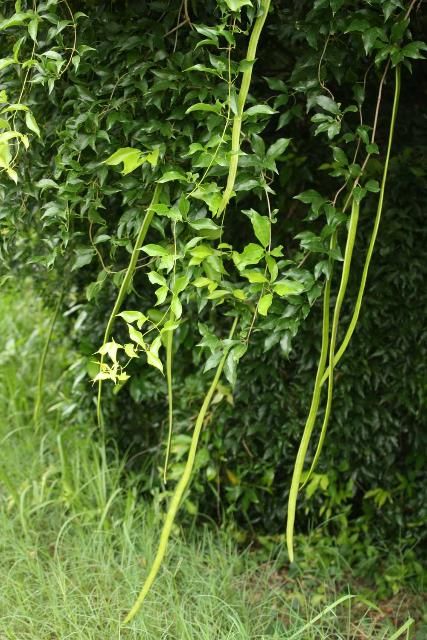
Credit: Niels Proctor, UF/IFAS
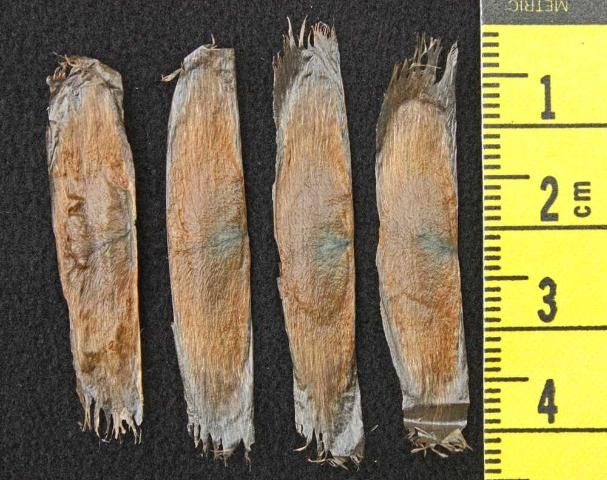
Credit: Niels Proctor, UF/IFAS
The below-ground portion of cat's-claw vine consists of a narrow taproot with a single swollen area that can be spherical or cylindrical (Figure 7). These swellings are sometimes loosely described as "tubers," but they occur in the root, rather than the stem, and are therefore more analogous to the swollen, edible portion of a radish or a carrot. Each swelling is 1–2 cm in diameter and can store large energy reserves. One study that looked at several infested sites in Australia found an average density of over 1,000 of these swollen root masses per square meter of forest floor (Osunkoya et al. 2009).
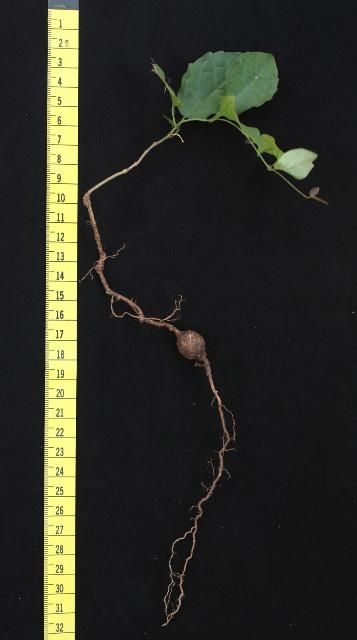
Credit: Niels Proctor, UF/IFAS
Control
Mechanical
Cutting the stem of cat's-claw vine at ground level will immediately kill off any large growth existing in a tree canopy, but the vine can quickly regrow from its taproot. It is theoretically possible to exhaust the energy reserves stored underground by continually cutting off the new shoots, but the process would be very labor-intensive and could take years to succeed.
Chemical
Cat's-claw vine is very susceptible to foliar herbicides, but large-scale application is almost impossible because the vine climbs trees and other plants that one would want to preserve. The UF Center for Aquatic and Invasive Plants recommends cutting the vines and treating the stumps with a full strength solution of glyphosate to kill the below-ground portion (Center for Aquatic and Invasive Plants).
Biological
Several promising biological controls for cat's-claw vine are currently being developed. South Africa is currently experimenting with the release of a leaf-tying moth (Hypocosmia pyrochroma) that will attack the leaves, fruits and seeds of cat's-claw vine (King, Williams, and Madire 2011). Other insects being used include lace bugs, leaf-mining beetles, and seed-feeding weevils. Scientists are also currently looking in Brazil for fungal pathogens that might have the potential to be biocontrol agents (da Silva, Barreto, and Pereira 2012).
Similar Native Vines
There are three native vines that are very similar to cat's-claw vine and are found in similar habitats in Florida (Figure 8). All three vines have opposite leaves and large, brightly colored flowers with funnelform to salverform corollas.
- Yellow jessamine [Gelsemium sempervirens (L.) W.T. Aiton] Native. Flowers are bright yellow. Blooms in late winter and usually finishes blooming before cat's-claw vine comes into bloom. Leaves are simple. Each leaf is roughly the same size and shape as a leaflet of cat's-claw vine.
- Crossvine [Bignonia capreolata L.] Native. Flowers are reddish-orange. Blooms for a brief period in mid-spring. Leaves are trifoliate, with two leaflets and a central tendril, but the tendril has no sharp claws.
- Trumpet creeper [Campsis radicans (L.) Seem.] Native. Flowers are red to orange. Leaves are opposite and pinnately compound, consisting of 5 to 9 leaflets.
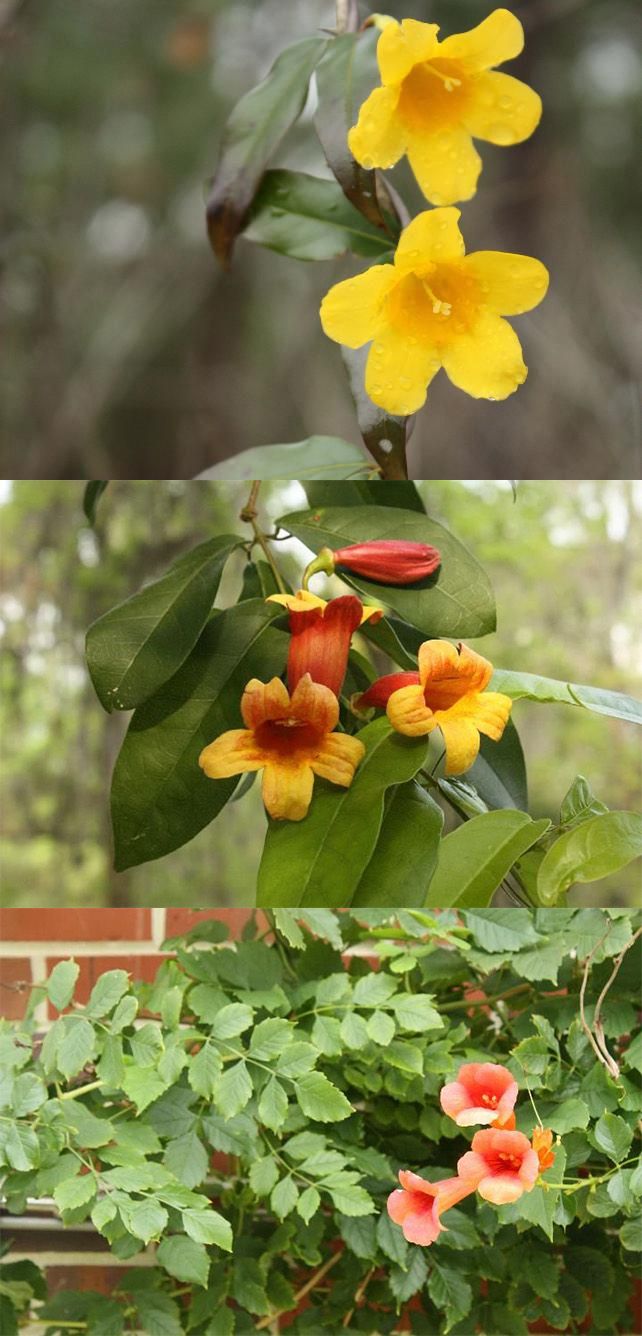
Credit: Niels Proctor, UF/IFAS
Other Climbing Vines with Large, Showy Flowers and Opposite Leaves
There are several other vines found in Florida that do not have as strong a resemblance to cat's-claw vine but share the traits of opposite leaves and showy flowers. A few of the more common ones are:
- Honeysuckle [Lonicera spp.] Both native and non-native.
- Milkweed vine [Morrenia odorata] Non-native.
- Rubber vine [Echites umbellatus] Native.
- Skunkvine [Paederia foetida] Non-native.
- Spanish arborvine [Merremia tuberosa] Non-native.
- Wild allamanda [Pentalinon luteum] Native.
Notes
1 http://www.flmnh.ufl.edu/herbarium/cat/search.asp?accno=73307
2 http://www.flmnh.ufl.edu/herbarium/cat/search.asp?accno=73299
3 http://www.flmnh.ufl.edu/herbarium/cat/search.asp?accno=73336
4 http://www.flmnh.ufl.edu/herbarium/cat/search.asp?accno=147304
5 http://www.flmnh.ufl.edu/herbarium/cat/search.asp?accno=147305
References
Anonymous. 2010. "Giant cat's claw discovered: Weed control worker stunned by massive creeper." The Daily Examiner, Grafton, New South Wales, Australia.
Boyne, Richard L., Susan P. Harvey, Kunjithapatham Dhileepan, and Tanya Scharaschkin. 2013. "Variation in leaf morphology of the invasive cat's claw creeper Dolichandra unguis-cati (Bignoniaceae)." Australian Journal of Botany no. 61 (6):419–423. https://doi.org/10.1071/BT13063
Center for Aquatic and Invasive Plants. 2014. Cat's-claw vine. University of Florida [accessed 4/23 2014]. Available from http://plants.ifas.ufl.edu/node/259.
da Silva, M., R. W. Barreto, and O. L. Pereira. 2012. "Fungal pathogens of 'cat's claws' from Brazil for biocontrol of Macfadyena unguis-cati." Mycotaxon no. 119 (Journal Article):181–195. https://doi.org/10.5248/119.181
King, A. M., H. E. Williams, and L. G. Madire. 2011. "Biological control of cat's claw creeper, Macfadyena unguis-cati (L.) AHGentry (Bignoniaceae), in South Africa." African Entomology no. 19 (2):366–377. https://doi.org/10.4001/003.019.0213
Lohmann, Lúcia G., and Charlotte M. Taylor. 2014. "A New Generic Classification of Tribe Bignonieae (Bignoniaceae)." Annals of the Missouri Botanical Garden no. 99 (3):348–489. https://doi.org/10.3417/2003187
Osunkoya, O. O., K. Pyle, T. Scharaschkin, and K. Dhileepan. 2009. "What lies beneath? The pattern and abundance of the subterranean tuber bank of the invasive liana cat's claw creeper, Macfadyena unguis-cati (Bignoniaceae)." Australian Journal of Botany no. 57 (2):132–138. https://doi.org/10.1071/BT09033
Rafter, M. A., A. J. Wilson, K. A. D. Wilmot Senaratne, and K. Dhileepan. 2008. "Climatic-requirements models of cat's claw creeper Macfadyena unguis-cati (Bignoniaceae) to prioritise areas for exploration and release of biological control agents." Biological Control no. 44 (2):169–179. https://doi.org/10.1016/j.biocontrol.2007.10.015
UCD Department of Plant Sciences. 2014. ENH 105 | Macfadyena unguis-cati. University of California at Davis 2009 [accessed 9/4 2014]. Available from http://www.plantsciences.ucdavis.edu/courses/enh105/labs/08/MAUN.html.
University of Florida, Institute of Food and Agricultural Sciences. 2018. "Assessment of Non-native Plants in Florida's Natural Areas" (https://assessment.ifas.ufl.edu, 4/29/2019) Gainesville, FL, 32611-4000, USA.
Ward, Daniel B. 2005. Putting a Stop to the Cat-claw Vine Infestation in Gainesville. Wildland Weeds, Summer, 2005, 17.